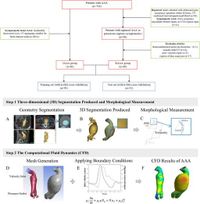Researchers have developed a method to assess the risk of abdominal aortic aneurysm (AAA) rupture using a combination of biomechanical and morphological analyses.
The study, published on March 20, 2025, employs a one-way fluid-structure interaction (FSI) model to distinguish between ruptured and asymptomatic intact AAAs. The analysis covered 66 patients with ruptured AAAs (RAAAs) and 66 patients with asymptomatic intact AAAs (IAAAs), matched by diameter, age, and sex.
The findings indicate that the tortuosity of the RAAAs was 1.4 times greater than that of the IAAAs (P = 0.0005). Additionally, the peak wall stress (PWS), maximum deformation (MD), and peak wall rupture index (PWRI) were found to be significantly elevated in RAAAs compared to IAAAs, with values corresponding to 1.18, 1.32, and 1.27 times higher, respectively (P = 0.0158, 0.0036, 0.0071).
Importantly, the location of maximum deformation showed a remarkable consistency with actual rupture locations in RAAAs, achieving an accuracy rate of 94.12%. This suggests that the MD position could serve as a valuable predictive indicator for AAA rupture risk.
To enhance predictive capabilities, a nomogram was developed incorporating key predictors—including aortic neck length (ANL), the ratio of intraluminal thrombus volume to AAA volume (VILT/VAAA), tortuosity, and MD. The nomogram demonstrated a predictive accuracy with an area under the curve (AUC) of 0.7604 (95% CI 0.6653–0.8556) along with an internal validation AUC of 0.8051 (95% CI 0.6400–0.9703).
AAAs can lead to life-threatening ruptures, emphasizing the importance of early detection and risk assessment. Current surgical criteria often rely heavily on AAA diameter, leaving significant room for improvement in rupture assessment methods.
The study highlights morphological complexities in RAAAs, finding that they have shorter aortic neck lengths and higher volumes of both the aneurysm and intraluminal thrombus compared to IAAAs. For instance, the mean VAAA was recorded at 328.50 cm2 for RAAAs against 225.20 cm2 for IAAAs.
The methodologies employed included a retrospective analysis of CT scans obtained from patients diagnosed with infrarenal AAAs from 2009 to 2022, ensuring that the data were robust and thorough.
The biomechanical indices collected in the research indicated that the mean PWS in RAAAs averaged at 0.5358 MPa, higher than the 0.4552 MPa documented in IAAAs (P = 0.0158). Additionally, wall shear stress (WSS) was found to be lower in RAAAs at 0.1859 MPa, compared to the IAAAs average of 0.2277 MPa (P = 0.0424).
The implications of these findings advocate for integrating biomechanics and morphology in clinical settings when evaluating AAA rupture risks. The researchers suggest that evolving methodologies could replace diameter-based assessments.
This study exemplifies the intersection of technology, engineering, and medicine in developing more personalized approaches to patient care, as the novel nomogram could significantly enhance clinical decision-making processes for assessing AAA rupture likelihood.
Future research may focus on validating these models in larger cohorts and determining the applicability of these findings across different demographics and AAA cases.




